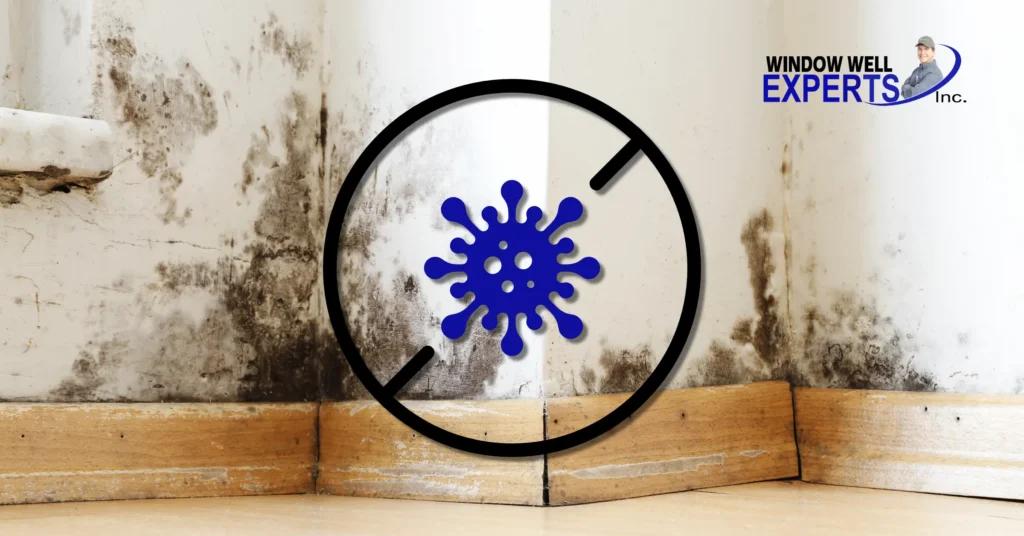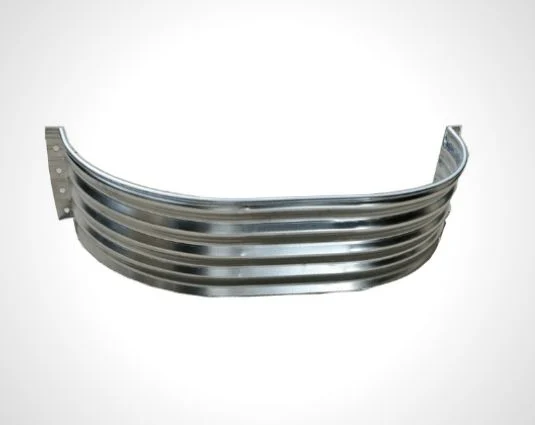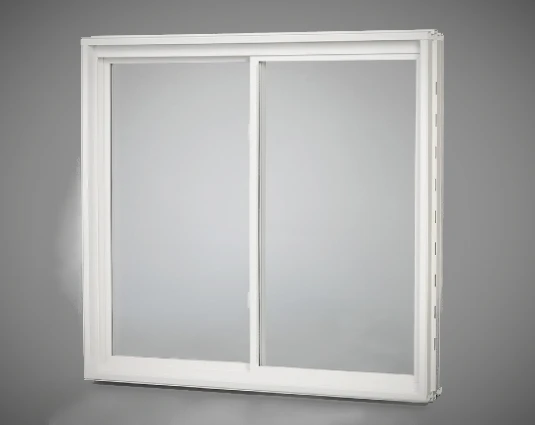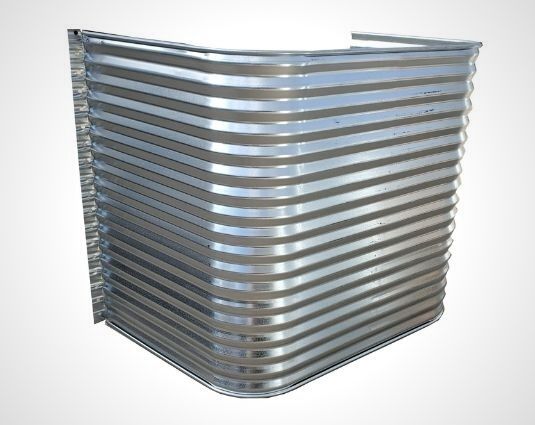Moisture and basements go hand in hand, but with some planning and preventative maintenance, it doesn’t have to. Most basements are completely below grade and have little, if any, fresh air access, or even much air circulation. These conditions lead to a dank, damp basement, then the downward spiral to mildew and mold begins. To prevent mold in basement, it’s essential to take proactive measures.
The Mayo Clinic has an easy to read article about mold and mildew allergies, and the health complications associated with them. The issues can be as minor as itchy eyes or sneezing, but can blow up to major complications with people with asthma, autoimmune diseases or other chronic health conditions.
Mold and mildew: the basics
Mildew is an easier fungus to deal with than its more persistent cousin mold. Mildew is generally a surface problem caused by the surface staying wet too long, such as on a bathroom tile. It is simple to remove by using 1:8 bleach and water solution, or a commercially available spray remover. Then the only thing you need to do to prevent it from happening again is to keep the surfaces dry by perhaps running an exhaust fan 15-30 minutes after a shower.
Mold is more persistent than mildew because it penetrates the surface of the wall, and often grows behind the drywall until it breaks through the paint surface. This calls for more vigorous remediation treatments, because simply removing the surface mold will not cure the problem.
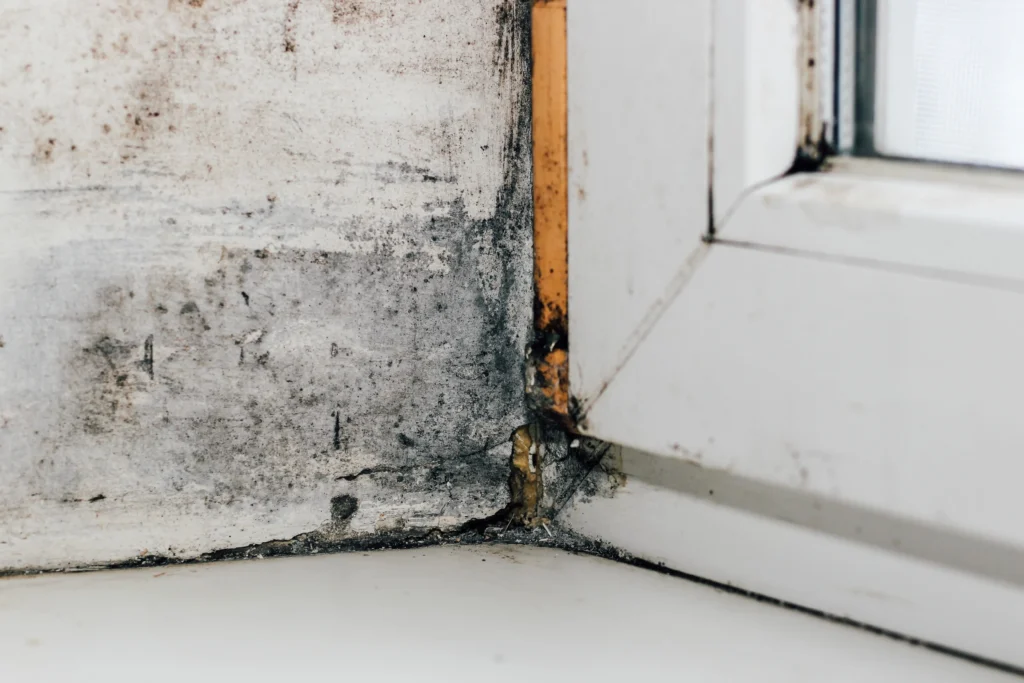
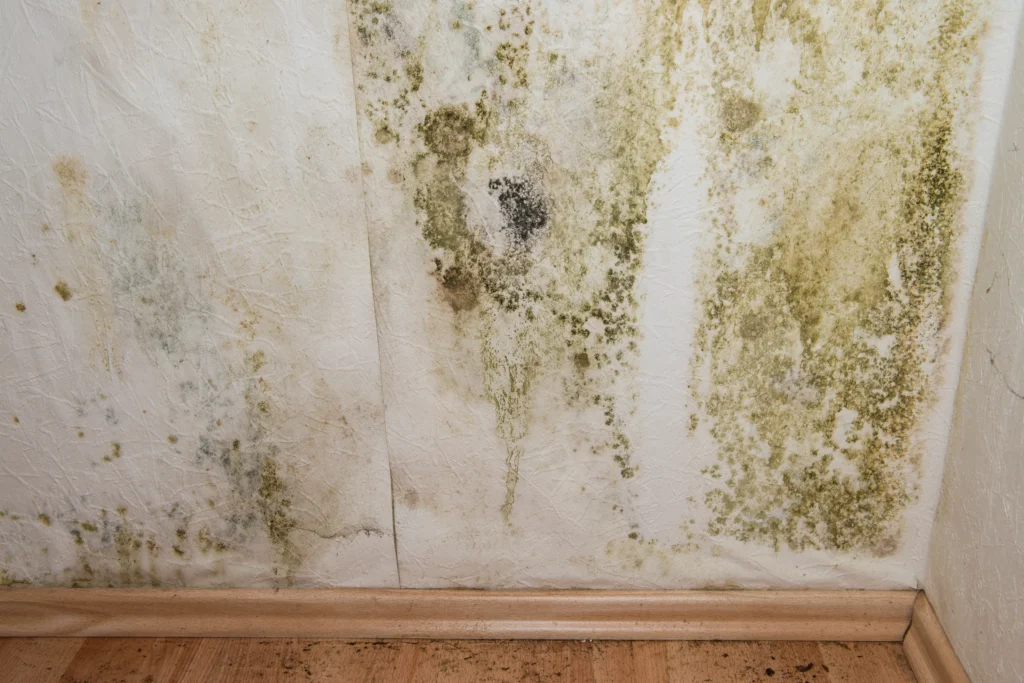
Assessing your home
This is a pretty extensive list, but a missed detail can cost a great deal of money. A little detective work, some research, and hopefully a few easy “to do” items crossed off your list will give you a much healthier home. Best of all, this list will also help you if you’re wondering how to prevent mold without air conditioning.
Go outside and critically look at your home. Consider the following:
- Does the landscaping slope AWAY from your home? If not, adding landscaping beds around your foundation wall to correct the slope will work wonders.
- Do your gutters and downspouts work properly and drain rainwater and snowmelt away from your home?
- Is your foundation sound?
- If you have window wells, are they firmly bolted to your home?
- Are they still rust free and intact?
- Is the bottom of the well – clear of leaves and debris?
- If it has a drain, is it blocked?
- The level of the gravel in the bottom of your well, is it at least 1-2 inches below the lower sill of the window?
- Lastly, does your window well come above grade by a few inches so that a heavy rain doesn’t “waterfall” into your well? A window well extension will help with this problem.
- Whether your basement windows are above grade or in a well, is the glazing around the panes and caulk around the windows intact or does it need some maintenance
Now, go look in your basement
- Is there any standing water in the basement? That is the first thing that MUST be remedied. Determine the source. Foundation crack? Leaking basement window? Leaking plumbing?
- Do you have drywall in your basement? Is the drywall in good condition? Are there any soft spots or signs of mold or mildew? If so, the affected drywall must be removed and the source determined.
- If you have foundation cracks, small ones may be a DIY fix with concrete caulk, hydraulic cement, or other readily available remedies. Large cracks should be evaluated by a professional.
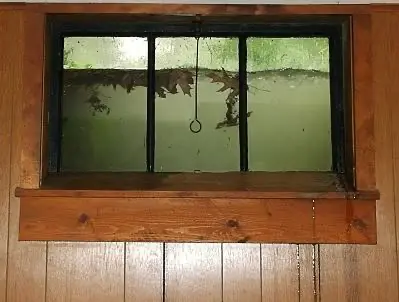
- If you have foundation cracks, small ones may be a DIY fix with concrete caulk, hydraulic cement, or other readily available remedies. Large cracks should be evaluated by a professional.
- If you have leaky plumbing, you may need a licensed plumber to correct the issues once and for all. If it is more than just a loose fitting, it is worth your peace of mind to have a professional do the work.
- Next, is the air musty? A dehumidifier that has a hose that drains into a floor drain will make your home much more comfortable in the summer months, and will make the air smell better. Mold and mildew cannot grow where there is no moisture.
- Change your furnace and A/C filters! Most manufacturers recommend monthly maintenance. Check your furnace’s manual and get the proper size for your unit. An air purification system can easily be added to a new furnace or air conditioner for a modest sum, and these units often have permanent filters that need to be on a regular basis. Dirty filters trap fungus, and may spread the threat throughout your home.
Basement and concrete basement walls
- Is there any standing water in the basement? That is the first thing that MUST be remedied. Determine the source. Foundation crack? Leaking basement window? Leaking plumbing? If you have leaky plumbing, you may need a licensed plumber to correct the issues once and for all. If it is more than just a loose fitting, it is worth your peace of mind to have a professional do the work.
- Are you actively sealing any cracks or gaps in the concrete basement walls to prevent moisture from seeping through and seeking ways to discover how to prevent mold on concrete basement walls? It’s crucial to inspect your basement walls for any cracks or gaps regularly. If you find any, use a high-quality waterproof sealant or caulk to seal them effectively. Ensure that the sealant is designed for concrete and can withstand moisture and pressure. Properly sealed walls act as a strong defense against moisture infiltration and mold growth. If these measures don’t work, it’s time to call in a basement specialist.
- Next, is the air musty? A dehumidifier that has a hose that drains into a floor drain will make your home much more comfortable in the summer months, and will make the air smell better. Mold and mildew cannot grow where there is no moisture.
- Do you have drywall in your basement? Is the drywall in good condition? Are there any soft spots or signs of mold or mildew? If so, the affected drywall must be removed and the source determined.
- Have you considered applying a waterproof coating or paint specifically designed for basement walls as a protective barrier against moisture? Applying a waterproof coating or paint to your basement walls is an excellent preventative measure. Look for products designed for basement walls, as they offer better protection against moisture. Before applying, make sure the walls are clean and dry. Follow the manufacturer’s instructions carefully for the best results. This coating creates a barrier that helps keep moisture out, reducing the conditions for mold to develop.
- Change your furnace and A/C filters! Most manufacturers recommend monthly maintenance. Check your furnace’s manual and get the proper size for your unit. An air purification system can easily be added to a new furnace or air conditioner for a modest sum, and these units often have permanent filters that need to be cleaned on a regular basis. Dirty filters trap fungus, and may spread the threat throughout your home.
Bathroom is next!
- Do you have an exhaust fan in your bathroom? If so, how effective is it? Try this easy test. Hold a facial tissue up to your fan while it is on. The airflow should pull the tissue to the fan grid and hold it there. If it doesn’t, take off the faceplate grid and vacuum the dust and debris that has accumulated. Try the test again – if it still fails, your exhaust fan should be replaced.
Still not sure what is going on?
There are infrared moisture meters readily available at home centers. These meters can sense temperature differences between dry and wet wall and floor surfaces and will help you narrow down the causes of your problems.
Airflow and ventilation
Air movement is vital to prevent mildew and mold. As discussed previously, an exhaust fan in every bathroom in your home is a necessity for mold prevention. The kitchen is another place where humidity and moisture collects and needs to be dissipated.
Your basement usually holds the machinery for air circulation. Newer high efficiency gas and fuel oil furnaces bring in outside air to heat, and also to vent combustion gasses. Have these checked on a yearly basis to be sure that nothing is cracked or leaking. In areas with heavy snowfall, be sure these pipes stay clear in the winter. A yearly checkup of your heating system is recommended and will prevent problems moving forward.
How can a window well help with ventilation and airflow?
A properly installed window well has a number of benefits. First and foremost, it is the best way to keep your family safe when you have living space, particularly a bedroom, in the basement. An egress window, whether an inswing or sliding window, will also provide an excellent source of both light and fresh air.
An open window makes a huge difference in a basement, even if it is opened only periodically. The fresh air will aid your air handling system in preventing stagnant air and moisture gathering in corners and unused rooms.
Air handling and correct circulation will prevent “dead spots”, but remember when decorating to place furniture, rugs, and wall hangings in such a way as to not block vents. Optimal air circulation keeps walls dry, preventing moisture buildup and mold and mildew.
Non egress size windows and wells can also play a part in your moisture control plan. Having cross ventilation is a big win for such a confined space. If there is a moisture issue that needs to be dried out, being able to put a fan in a window to draw moisture out of the house is a big win!
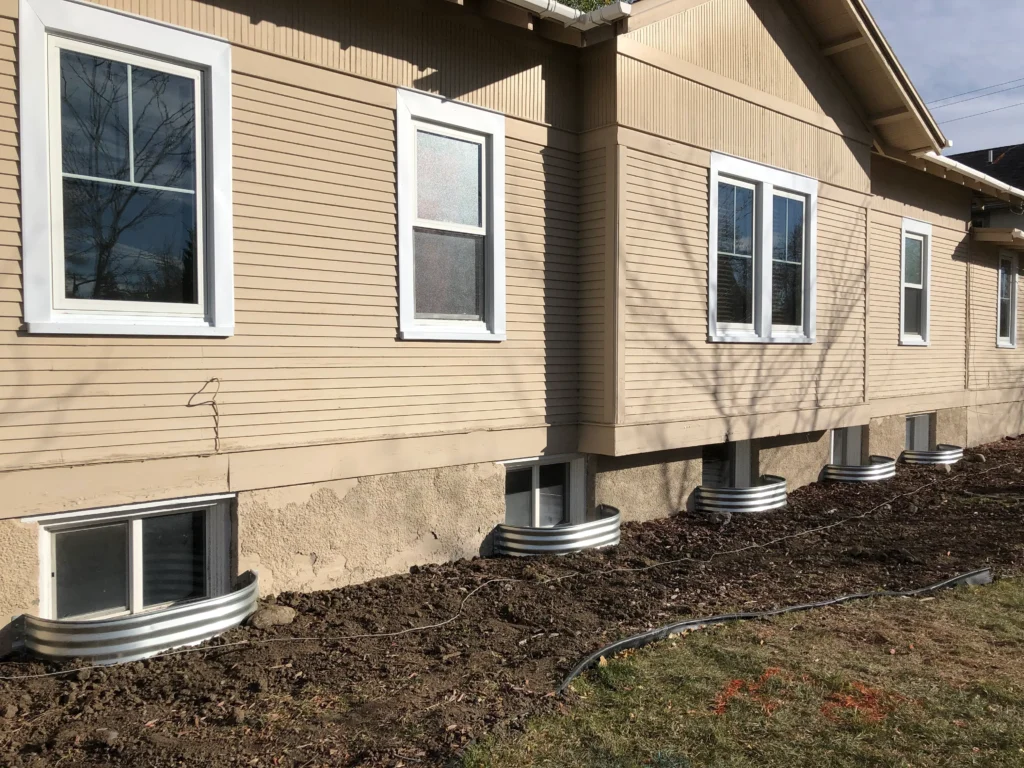
Cover your window well!
Covering your window wells is simply common sense when it comes to water problems. The correct window well cover will make a big difference. Water can’t leak into your home if it isn’t in your well!
Consider options like covers with hinged portions that will make ventilation easy. Burglar resistant locks will aid in home security. Decorative liners will change the view out your window well to whatever you choose – a beach, scenic lakes or mountains, even outer space.
Maintenance and upkeep for preventing mold in the basement
This can be the easy part. It’s suggested once a month to replace the furnace or A/C filter, and at that time do a quick look around in your basement. Here’s some suggestions:
- Quickly check the corners of each room, both floor and ceiling for the signs of moisture collecting, mold, or mildew.
- In the utility room, check for any drips from the utility sink or washing machine.
- If any of the ceilings are unfinished, take a quick look with a flashlight at the pipes and heating/cooling system ducts for any problems.
A mold free basement
A mold free basement is beneficial for every home. The occupants are healthier because the air is free of mold allergens. The air in the home smells fresh. The home is solid and rot free.
Taking action by having solid window wells with durable, great fitting covers to protect the basement windows, especially the windows at grade level, will prevent a large number of the water problems that we see on a daily basis. Once your window well is installed correctly, you can fix the interior damage and not see trouble again.
Give us a call at 888-650-9355 to talk to one of our knowledgeable representatives about the issues that you are having. We will be happy to help!

